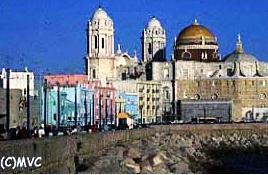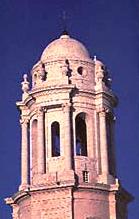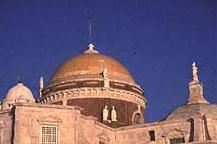|
Kadyks,
Cadiz
W starożytności Gades jest najstarszym miastem Europy. Wedle
obliczeń miejscowych taksówkarzy liczy sobie 3017 lat. Jest to miasto radosne,
atmosferą przypomina Antyle. Jego szczególną cecha jest eklektyzm, który
przejawia się w architekturze i w zróżnicowanym sposobie życia jego mieszkańców.
Warte tu są do zobaczenia ruiny rzymskiego amfiteatru, mury obronne z XVII w.,
kościoły (XVII-XIX w.) z dziełami sztuki z XVII-XVIII w., katedra
neoklasycystyczna (XVIII-XIX w.), parki, muzea. Należy też wspomnieć o Oratorio
de San Felipe Neri czyli miejscu ważnego, historycznego wydarzenia. Tutaj w 1812
roku została odczytana publicznie liberalna konstytucja. Tak więc Kadyks można
uznać za kolebkę hiszpańskiej demokracji, często wcześniejszej niż w wielu
innych krajach Europy.
Kadyks - miasto założone przez
Fenicjan w 1100 r p.n.e. Kiedy w 1812 r. Kortezy uchwaliły tutaj pierwszą
narodową konstytucję stał się na krótko stolicą Hiszpanii. Barokowa katedra z
XVIII jest poddawana niszczącym wpływom morskiego klimatu, piaskowiec, z którego
jest zbudowana miejscami wygląda jak sito. Ulica prowadząca do katedry jest
monitorowana przez umieszczone na dachach kamery na długich wysięgnikach.
Nowa
encyklopedia powszechna PWN © Wydawnictwo Naukowe PWN SA
KADYKS,
Cádiz, m. w pd.-zach. Hiszpanii, w regionie Andaluzja, na półwyspie (dł.
9 km) oddzielającym odnogę Zat. Kadyksu od O. Atlantyckiego. — 154 tys. mieszk.
(1991); ośr. adm. prowincji Kadyks. Założony ok. 1100 p.n.e. przez Fenicjan p.n.
Gadir; od ok. 500 p.n.e. pod władzą Kartaginy; 206 p.n.e. opanowany przez
Rzymian (łac. Gades), okres rozkwitu gosp.; w V w. zniszczony przez Wizygotów;
od 711 pod panowaniem muzułm.; od 1262 należał do Kastylii; w XVI–XVIII w. gł.
baza żeglugi transatlantyckiej, partycypował w monopolu Sewilli na handel
z koloniami w Ameryce; wielokrotnie atakowany przez flotę bryt. (m.in. przez F.
Drake'a, hr. Essexa, H. Nelsona); 1810–12 oblegany przez wojska napoleońskie,
1810–13 siedziba Junty Centr. i Kortezów, miejsce uchwalenia pierwszej hiszp.
konstytucji; 1820 wybuch rewolucji liberalnej; w czasie wojny domowej 1936–39
w rękach nacjonalistów. Port handl., pasażerski, wojenny i rybacki; przemysł
stoczn., metal., spoż. (rybny, winiarski, tytoniowy); wydział med. uniw.
w Sewilli, wyższa szkoła muz.; muzea; znany ośr. turyst., kąpielisko mor.;
renes. katedra Parroquía de S. Cruz, mury obronne z XVII w., kaplica S. Felipe
de Neri z XVII w., katedra z XVIII–XIX w., liczne kościoły, m.in. Santiago, S.
Catalina (zw. Los Capuchinos, XVII w.), szpital Nuestra Señora del Carmen
z XVIII w.
The History
of Cádiz
Cadiz is
thought by some to be the oldest city in Europe, founded in 1100 BC by the
Phoenicians who called it Gadir and traded Baltic amber and British tin, as well
as Spanish silver. The city subsequently became a naval base for the Romans
before fading into obscurity until 1262 when it was taken from the Muslims by
Alfonso X.
The real boom
period was with the discovery of America as Columbus sailed from this port on
his second and fourth voyages. Much later the city enjoyed a golden age during
the 18th century when it enjoyed 75% of Spanish trade with America. From this
time it grew into one of the wealthiest and most cosmopolitan cities in Spain
and most of the city's fine buildings date from this time.



Monuments in the City of Cadiz
Cathedral
Nueva
A grandiose structure capped by a dome of golden tiles was described by Richard
Ford as "a stranded wreck on a quicksand." This 18th Century Baroque cathedral
gets few visitors. This is a welcome change after the hordes of visitors in
places such as Seville, so you have the cathedral experience, as it should be -
in silence. A highlight is the lower floor. If you stand in the middle of the
circular basement and make a noise the echo effect it produces is truly
wonderful.
An impressive collection of church treasures can be viewed and in the crypt lies
the tomb of composer Manuel de Falla, a Cadiz native, whose music is evocative
of the magic of Andalucia. The best external view of the cathedral is to walk
along the sea front behind it so you can observe the golden dome.
Price: 3
euros
Fine Arts and
Archaeology Museum
The archaeology museum on the ground floor is worth a look. Some excellent
glassware and jewellery are highlights and there is a good collection of
amphorae as you'd expect from an historic port.
The Fine Arts museum on the second floor includes a Rubens canvas and the pride
of the collection is a set of canvasses by Zurbaran.
On the third floor there is allegedly a wonderful collection of puppets used for
biting satirical plays.
Plaza de Mina
Open: Tues and Sun 9.30-2 pm
Price: 1.5 euros
Tel: 956 21
22 81
Oratorio de
Santa Cruz
This church is divided into two very distinct parts: the gloomily simplistic
oval 18th century chapel with only a crucifixion sculpture; and the contrasting
upper floor, elegantly decorated and containing some fine Goya paintings
depicting the Miracle of the Loaves and Fishes, the Guest at the Wedding and the
Last Supper. An excellent free guide is given upon entry.
Calle Rosario
Price: 1.5 euros
Tel 956 22 22 62
Oratori de
San Feligo Neri
Historically this building is important as it is where a group of radicals met
in 1812 to produce a blueprint of liberalism espousing the sovereignty of the
people of Spain over the throne. However there is nothing of note inside the
church. There is an adjoining museum.
Price: 1.5
euros
Iglesia de
San Felipe Neri
A place of pilgrimage for democracy-loving Spaniards, since it was here that
parliament gathered in 1812 to proclaim a liberal constitution and it was here
that the Cortes of Cadiz met when the rest of Spain was subjected to the rule of
Napoleon's brother, Joseph Bonaparte, more popularly known as Pepe Botella for
the love of the bottle. On the main alter is an Immaculate Conception by
Murillo, the great Sevillian artist who in 1682 fell to his death from a
scaffolding while working on his Mystic Marriage of St. Catherine in the Chapel
of Santa Catalina.
C/ Santa
Ines.
Tel: 956 21 16 12
Museo
Historico Municipal
Boasts a 19th century mural depicting the establishment of the Constitution of
1812. The real showpiece is a fascinating mahogany and ivory model of the city
which dates back to 1779 and which is a fascinating duplicate of all the streets
and the buildings much as they are today.
C/ Santa
Ines.
Tel: 956 22 17 88
Gran Teatro,
Manuel de Falla
This theatre is located within a wonderful neo-Mudejar red brick building and
has an impressive interior as well. There is an active programme throughout the
year, check the tourist office for a schedule of events.
Hospital de
Mujeres
This hospital has a brilliant El Greco of St Francis in Ecstasy, depicting the
grey-cloaked saint experiencing a mystical vision.
C/ San
Francisco
Ayuntamiento
The city town hall overlooks the Plaza San Juan de Dios and was constructed in
two stages, the first in 1799, the latter in 1861.
Torre Tavira
This highest and most important of the city's old watchtowers is a fine place to
get your bearings and affords a dramatic panorama of the city. Back in the 18th
century, Cadiz had no less than 160 towers to watch over its harbours.
C/Marques del
Real Tesoro 10.
Calle Ancha
A couple of blocks west of the Oratorio de San Felipe Neri is C/ Ancha, the main
street of late 18th and early 19th century Cadiz. The cafes and bars here were
the unofficial gathering and debating places for members of the 1812 Cortes.
|

